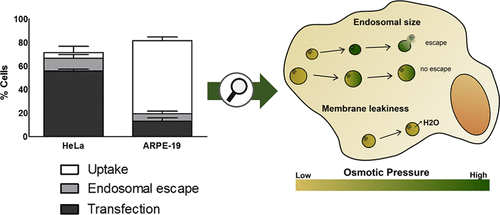Our official English website, www.x-mol.net, welcomes your feedback! (Note: you will need to create a separate account there.)
Endosomal Size and Membrane Leakiness Influence Proton Sponge-Based Rupture of Endosomal Vesicles
ACS Nano ( IF 17.1 ) Pub Date : 2018-03-05 00:00:00 , DOI: 10.1021/acsnano.7b07583 Lotte M. P. Vermeulen 1 , Toon Brans 1 , Sangram K. Samal 1 , Peter Dubruel , Jo Demeester 1 , Stefaan C. De Smedt 1 , Katrien Remaut 1 , Kevin Braeckmans 1
ACS Nano ( IF 17.1 ) Pub Date : 2018-03-05 00:00:00 , DOI: 10.1021/acsnano.7b07583 Lotte M. P. Vermeulen 1 , Toon Brans 1 , Sangram K. Samal 1 , Peter Dubruel , Jo Demeester 1 , Stefaan C. De Smedt 1 , Katrien Remaut 1 , Kevin Braeckmans 1
Affiliation

|
In gene therapy, endosomal escape represents a major bottleneck since nanoparticles often remain entrapped inside endosomes and are trafficked toward the lysosomes for degradation. A detailed understanding of the endosomal barrier would be beneficial for developing rational strategies to improve transfection and endosomal escape. By visualizing individual endosomal escape events in live cells, we obtain insight into mechanistic factors that influence proton sponge-based endosomal escape. In a comparative study, we found that HeLa cells treated with JetPEI/pDNA polyplexes have a 3.5-fold increased endosomal escape frequency compared to ARPE-19 cells. We found that endosomal size has a major impact on the escape capacity. The smaller HeLa endosomes are more easily ruptured by the proton sponge effect than the larger ARPE-19 endosomes, a finding supported by a mathematical model based on the underlying physical principles. Still, it remains intriguing that even in the small HeLa endosomes, <10% of the polyplex-containing endosomes show endosomal escape. Further experiments revealed that the membrane of polyplex-containing endosomes becomes leaky to small compounds, preventing effective buildup of osmotic pressure, which in turn prevents endosomal rupture. Analysis of H1299 and A549 cells revealed that endosomal size determines endosomal escape efficiency when cells have comparable membrane leakiness. However, at high levels of membrane leakiness, buildup of osmotic pressure is no longer possible, regardless of endosomal size. Based on our findings that both endosomal size and membrane leakiness have a high impact on proton sponge-based endosomal rupture, we provide important clues toward further improvement of this escape strategy.
中文翻译:

内体大小和膜渗漏影响基于质子海绵的内囊泡破裂
在基因治疗中,内体逃逸是一个主要的瓶颈,因为纳米粒子通常会残留在内体中并被运往溶酶体进行降解。对内体屏障的详细了解将有助于制定合理的策略来改善转染和内体逃逸。通过可视化活细胞中的个体内体逸出事件,我们了解了影响基于质子海绵的内体逸出的机械因素。在一项比较研究中,我们发现,与ARPE-19细胞相比,用JetPEI / pDNA多聚体处理的HeLa细胞的内体逃逸频率提高了3.5倍。我们发现内体大小对逃逸能力有重大影响。较小的HeLa内体比较大的ARPE-19内体更容易受到质子海绵的作用而破裂,基于基本物理原理的数学模型所支持的发现。仍然引人入胜的是,即使在小的HeLa内体中,<10%的含复合体的内体也显示出内体逃逸。进一步的实验表明,含多聚体的内体的膜对小化合物渗漏,阻止了渗透压的有效积累,进而阻止了内体破裂。对H1299和A549细胞的分析表明,当细胞具有可比的膜渗漏性时,内体大小决定了内体逃逸效率。但是,在高水平的膜渗漏下,无论内体大小如何,都不再可能形成渗透压。根据我们的发现,内体大小和膜泄漏对基于质子海绵的内体破裂都具有很大的影响,
更新日期:2018-03-05
中文翻译:

内体大小和膜渗漏影响基于质子海绵的内囊泡破裂
在基因治疗中,内体逃逸是一个主要的瓶颈,因为纳米粒子通常会残留在内体中并被运往溶酶体进行降解。对内体屏障的详细了解将有助于制定合理的策略来改善转染和内体逃逸。通过可视化活细胞中的个体内体逸出事件,我们了解了影响基于质子海绵的内体逸出的机械因素。在一项比较研究中,我们发现,与ARPE-19细胞相比,用JetPEI / pDNA多聚体处理的HeLa细胞的内体逃逸频率提高了3.5倍。我们发现内体大小对逃逸能力有重大影响。较小的HeLa内体比较大的ARPE-19内体更容易受到质子海绵的作用而破裂,基于基本物理原理的数学模型所支持的发现。仍然引人入胜的是,即使在小的HeLa内体中,<10%的含复合体的内体也显示出内体逃逸。进一步的实验表明,含多聚体的内体的膜对小化合物渗漏,阻止了渗透压的有效积累,进而阻止了内体破裂。对H1299和A549细胞的分析表明,当细胞具有可比的膜渗漏性时,内体大小决定了内体逃逸效率。但是,在高水平的膜渗漏下,无论内体大小如何,都不再可能形成渗透压。根据我们的发现,内体大小和膜泄漏对基于质子海绵的内体破裂都具有很大的影响,



























 京公网安备 11010802027423号
京公网安备 11010802027423号